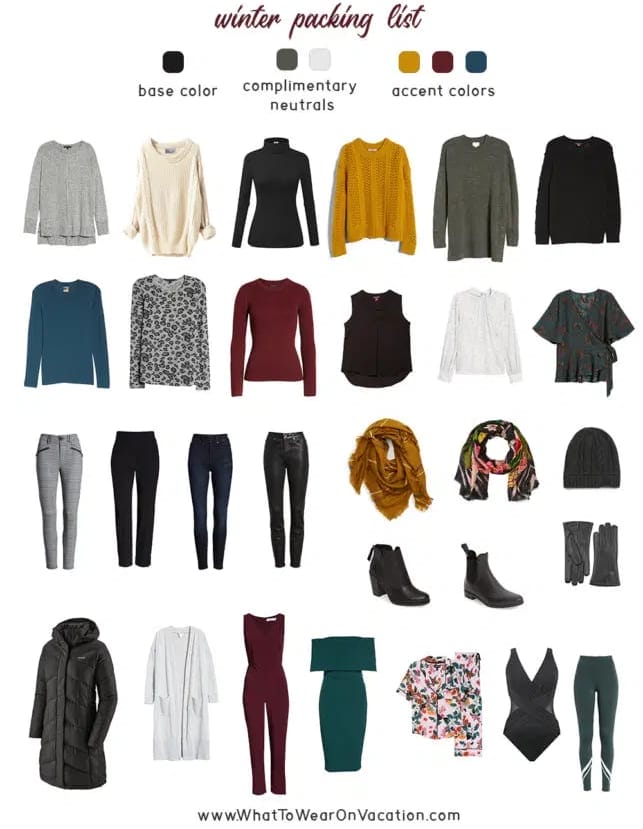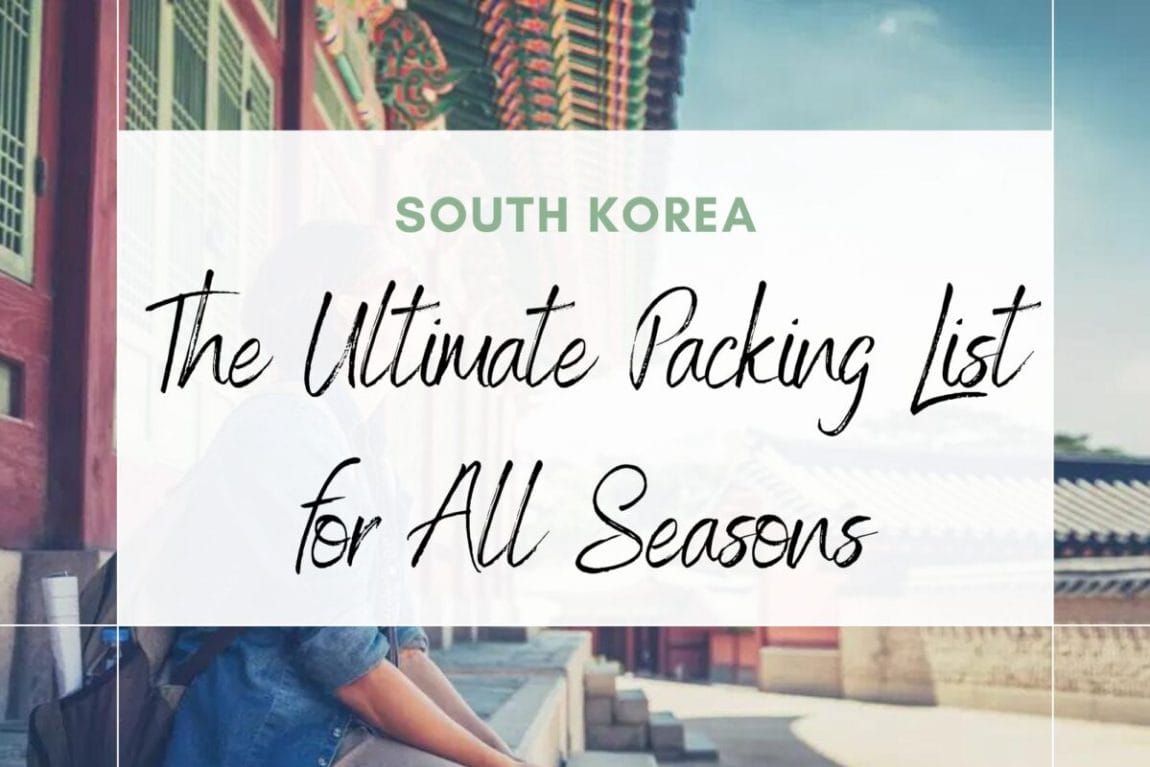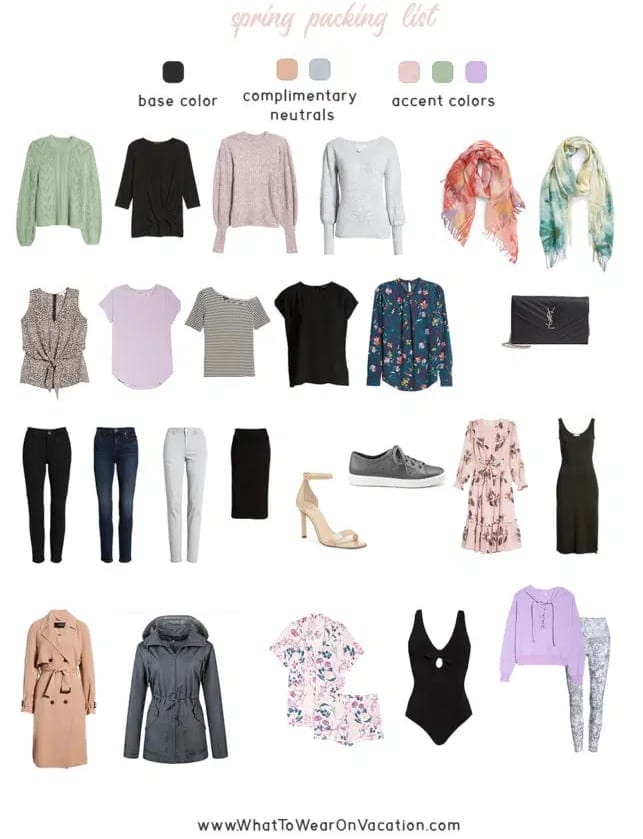Embracing both the heat of summer festivals and the tranquillity of winter vistas, South Korea is a jewel nestled in East Asia, inviting travelers with a myriad of experiences that necessitate a comprehensive packing list. If your plans include getting lost in the electrifying nightlife of Busan or being spellbound by the cherry blossoms of Seoul, rest assured, this all-season packing guide has you covered. So fasten your seatbelts and get ready to plunge into the captivating universe of K-fashion, indispensable tech gadgets, and essentials tailored to each season that will ensure your South Korean escapade becomes an unforgettable tale!
Travel essentials to pack all year round
- Travel Insurance: Don't forget to secure a reliable insurance plan before you jet off! be it lost luggage, unexpected health issues, or trip cancellations. Compare various insurance providers here.
- Your passport is your gateway to global adventures: make sure it's valid and extends well beyond your planned stay in South Korea. Plus, keep a page clear for those coveted new stamps—little souvenirs of your journey!
- Flight information, boarding passes, and airline tickets should always be within arm's reach—they're your private wings, soaring you across the heavens.
- Your accommodation details, particularly the address, are essential. Not only do they lead you to your temporary Korean home, but they also streamline those pesky customs forms.
- Planning a lengthy romance with South Korea? Remember, a stay beyond 90 days typically requires a visa. Double-check your visa needs to ensure your stay is as smooth as kimchi.
- Got your hotel transfers booked in advance? Excellent! Just make sure the details are accessible once you land in the Land of the Morning Calm.
- A travel eSIM card with data plan for your smartphone to stay connected.
- Now onto the finance bit! Carry some cash and credit cards for those spontaneous shopping trips or tranquil visits to traditional teahouses.
- Lastly, don't forget other forms of identification, like your driver's license. You never know when they might turn into handy tools on your adventure!
In addition to the absolute must-haves, we've curated a list of 14 essential items that promise to enhance your South Korean voyage with convenience, safety, and a sprinkle of fun. We've got you covered, from pragmatic items like a universal travel adapter and a filtered water bottle, to delightful additions such as pocket Wi-Fi and a travel pillow. Immerse yourself in our South Korean Essentials Checklist to ensure nothing slips your mind!
Clothing Tips for the South Korean Winter
When dressing for winter in South Korea, think warm and stylish. The temperatures can dip well below freezing, especially in January. It's crucial to pack thermal layers, including sweaters, thermal socks, and a heavy coat, preferably with a hood to protect against wind and snow. Don't forget your hats, scarves, and gloves—they're both functional and fashionable. Waterproof boots are also a must to navigate snowy or wet streets. With these in your suitcase, you'll be ready to embrace the South Korean winter, all while looking like a local!

- Embrace Layering: In South Korea's winter, the key is to layer your clothes. Start with thermal undergarments, add a cozy sweater, and top it off with a heavy coat or parka. This way, you can adjust your clothing to your comfort as temperatures fluctuate.
- Invest in Good Footwear: It's important to have waterproof, insulated boots to walk comfortably on snowy streets. Consider boots with good grip to avoid slips and falls on icy pavements.
- Protect Your Extremities: A hat, scarf, and gloves are essential to protect your extremities from the freezing cold. Opt for gloves compatible with touch-screen devices so you don't have to take them off when using your phone.
- Thermal Socks are Essential: Keep your feet warm with thermal socks, preferably made of wool, to maintain heat and wick away moisture.
- Choose Windproof and Waterproof Outerwear: Winters in South Korea can be windy, making the temperature feel even colder. Choose windproof and waterproof outerwear to shield you from chilling winds and potential snowfall.
- Remember Warm Pajamas: Nighttime temperatures can drop significantly, so be sure to pack warm pajamas. Fleece or flannel ones are good choices for staying toasty at night.
- Pack Moisture-Wicking Undergarments: Cold weather often means bundling up, which could lead to sweating when indoors. To stay comfortable, consider moisture-wicking undergarments that will keep you dry and warm.
- Accessorize with a Heat Pack: Heat packs or hot hands are portable pouches that produce heat due to a chemical reaction. They're great for extra warmth—just slip them in your pocket or gloves.
- Consider Long Coats: A long coat that covers your thighs can add an extra layer of warmth. They also add a touch of style to your winter wardrobe!
- Choose Colors Wisely: Dark colors absorb sunlight and can help keep you warm. Opt for darker clothing during the day to take advantage of this natural heat source.
Packing list for Winter in South Korea (December, January, February)
Here's a comprehensive packing list for a winter trip to South Korea:
- Thermal Undergarments: To provide a warm base layer.
- Warm Sweaters: Opt for wool or cashmere for best heat retention.
- Winter Coat: Down-filled, windproof, and waterproof is the best.
- Long Pants: Jeans or thermal pants to keep your legs warm.
- Thermal Socks: Preferably woolen, for maximum warmth.
- Waterproof Boots: Insulated and with a good grip for icy streets.
- Hat, Scarf, and Gloves: Crucial for protecting your extremities from the cold.
- Warm Pajamas: Fleece or flannel are cozy choices.
- Moisture-Wicking Undergarments: To stay dry when moving from cold outdoors to heated indoors.
- Heat Packs: Portable, disposable heat packs can be slipped into pockets or gloves for extra warmth.
- Travel Umbrella: For the occasional winter rain shower.
- Skincare Products: Cold weather can be harsh on skin, so don't forget moisturizer, lip balm, and sunscreen.
- Travel Adapter: South Korea uses Type C and F outlets.
- Pocket Wi-Fi or SIM Card: To stay connected during your travels.
- Sunglasses: Winter sun can be surprisingly bright, especially when reflecting off snow.
Remember, winter in South Korea can be beautiful, but also very cold, so packing appropriately will help ensure a comfortable and enjoyable trip!
What NOT to Wear in Winter?
- Skip the Thin Fabrics: Lightweight materials like linen and cotton won't provide enough warmth during a South Korean winter. Stick to thicker, more insulating fabrics such as wool or fleece.
- Avoid Inadequate Footwear: Flip flops, sandals, or non-waterproof shoes are a big no-no. They won't protect your feet from cold temperatures or wet conditions.
- Leave the Short Sleeves at Home: Even with indoor heating, short-sleeved shirts can be uncomfortably cool. Opt for long sleeves to stay warm indoors and out.
- Don't Rely on a Single Layer: Wearing just one thick layer won't cut it in the chilly Korean winter. You need multiple layers to effectively trap body heat and adapt to different environments.
- No to Tight Clothing: Avoid tight clothing as it may restrict blood circulation, which is necessary for maintaining body warmth. Clothes should be snug but not too tight.
- Say No to Non-insulated Coats: While a non-insulated coat might look stylish, it won't provide the necessary warmth. Choose a well-insulated, preferably down-filled coat to protect you from the biting cold.
Clothing Tips for Spring in South Korea
Spring in South Korea is the epitome of grace and beauty, with temperatures ranging from cool to mildly warm, so your clothing choices should reflect this spirit. A versatile trench coat or lightweight jacket can be your best friend for the often chilly mornings and evenings. Layering is key, so pack a combination of long-sleeved tops and light sweaters that can be easily added or removed as the temperature fluctuates throughout the day. Don't forget to pack a few stylish dresses or skirts for the days you want to feel extra feminine, perhaps to blend in with the dreamy cherry blossoms. Lastly, comfortable walking shoes are essential for exploring vibrant cityscapes and serene temples. Oh, and an umbrella – sudden spring showers can catch you off-guard!
Packing list for Spring in South Korea (March, April, May)
- Lightweight Trench Coat or Jacket: Essential for cooler mornings and evenings.
- Water-Resistant Windbreaker: For sudden spring showers.
- Long-Sleeved Tops: Great for layering as the temperature can fluctuate.
- Short-Sleeved Tops: For the warmer afternoons.
- Light Sweaters or Cardigans: To layer over tops on cooler days.
- Comfortable Pants: Choose versatile ones that can be dressed up or down.
- Jeans: A universally adaptable item.
- Midi Skirt: A stylish option for warmer days or dressier occasions.
- Casual Dress: Easy to dress up or down for various outings.
- Formal Dress: For special nights out.
- Comfortable Walking Shoes: Ideal for daily exploration.
- Dress Shoes: Suitable for dinners or nightlife.
- Scarf: Can provide both warmth and a fashionable accent.
- Pajamas: For a comfortable night's sleep.
- Undergarments and Socks: Don't forget these daily essentials!
Remember, South Koreans are known for their stylish and often conservative dressing, so ensure your clothing choices are respectful of the local culture. It's always a good idea to check the weather forecast before you start packing!
What NOT to wear in Spring
- Heavy Winter Clothes: As the weather warms up, heavy winter garments like thick coats, heavy sweaters, or winter boots can become too hot and cumbersome.
- Non-water-resistant Footwear: Sudden showers can catch you by surprise, so it's best to avoid shoes that can easily get ruined by water.
- Pure White Clothing: Springtime can sometimes be quite muddy due to rainfall, so very light clothes might get dirty easily.
- Overly Revealing Clothes: While the weather is warming up, it's worth noting that South Korean culture leans towards modest fashion, especially in traditional or religious settings.
- Thin Summer Clothes: Spring weather can still be quite cool, especially in the mornings and evenings, so very light summer clothing might not provide enough warmth. Layering is key during this season.
Clothing Tips for Summer in South Korea
Summer in South Korea can get quite hot and humid, so it's essential to pack breathable, lightweight clothing to stay comfortable. Consider bringing loose-fitting dresses, shorts, and blouses made of fabrics like linen or cotton that will help keep you cool. Despite the heat, it's worth noting that many South Koreans dress modestly, so avoid overly revealing outfits; opt for knee-length shorts and skirts, and cover your shoulders when visiting religious or traditional sites. Don't forget a swimsuit for beach trips and a light jacket or cardigan for cooler evenings or air-conditioned places. Lastly, a pair of comfortable walking sandals is a must for exploring cities and attractions during the hot summer days.
Packing list for Summer in South Korea (June, July, August)
- Loose Cotton or Linen Tops: Breathable and light for hot summer days.
- Shorts: Consider knee-length for modesty.
- Lightweight Pants: Ideal for cooler evenings or more formal occasions.
- Summer Dresses: Light, breathable fabric dresses are perfect for hot weather.
- Light Cardigan or Jacket: For cooler nights or air-conditioned places.
- Swimsuit: Don't forget this if you plan to hit the beach or pool.
- Comfortable Walking Sandals: Ideal for daily sightseeing.
- Closed-toe Shoes: Useful if planning outdoor activities like hiking.
- Undergarments: Including enough for your entire trip or plan for laundry.
- Pajamas: Lightweight ones for a comfortable night's sleep.
- Sun Hat: To protect from the strong summer sun.
- Sunglasses: Essential for sun protection.
- Light Scarf: Can add a fashionable touch to outfits and provide some warmth in cooler or air-conditioned places.
- Formal Outfit: A dress or nice top and pants for special evenings out.
- Socks: If you plan on wearing closed-toe shoes for any of your outings.
Remember to pack colors and styles that you can mix and match. Also, while South Korea is modern, it's still generally conservative when it comes to dress, especially at religious or traditional sites. Check the weather before your trip to make any last-minute adjustments to your packing list.
What NOT to wear in Summer
- Dark and Heavy Clothing: These absorb more heat, making you feel hotter in the already warm temperatures.
- Synthetic Fabrics: Materials like polyester or rayon may not breathe well, causing discomfort in the heat.
- Tight Clothes: These can cause discomfort in hot, humid weather and may not be as breathable as looser garments.
- High Heels for Sightseeing: While they might be stylish, they can be very uncomfortable for walking long distances or exploring hilly areas.
- Overly Revealing Clothes: Despite the heat, it's important to remember that South Korea tends to be conservative in dress, especially at religious or traditional sites. Very short shorts or skirts, and tops that reveal a lot of cleavage or the midriff, might not be seen as appropriate.
Clothing Tips for Fall in South Korea
xperiencing autumn in South Korea is truly a feast for the eyes, with fall foliage painting the landscapes in stunning hues. As the temperature starts to drop, be sure to pack warmer clothing. Layering is the key for autumn, so include a mix of long-sleeved tops, sweaters, and lighter jackets or cardigans. A sturdy, yet stylish pair of boots will be useful for exploring city streets or autumn trails. Consider packing some scarves for both warmth and fashion, and remember a good-quality rain jacket or umbrella for unexpected showers. Lastly, South Korea's fashion scene is quite trendy, so don't shy away from incorporating some autumn colors and current styles into your travel wardrobe.
Packing list for Fall in South Korea (September, October, November)
- Long-Sleeved Tops: Essential for layering as the weather cools.
- Sweaters: Perfect for the chilly fall weather.
- Light Jacket or Cardigan: For cooler evenings or layering.
- Rain Jacket or Umbrella: For unexpected showers.
- Pants or Jeans: Stylish and comfortable for the autumn temperature.
- Warm Dress: You can layer this with tights and a cardigan.
- Scarf: Adds warmth and a fashionable touch.
- Comfortable Walking Shoes: Great for daytime exploration.
- Boots: Practical yet stylish for walking and going out in the evening.
- Undergarments: Including enough for your entire trip or plan for laundry.
- Pajamas: Ensure they're warm enough for the cooler nights.
- Socks: Warm ones if you're bringing boots.
- Formal Outfit: A dress or nice top and pants for special evenings out.
- Gloves: Depending on how late in fall, you might appreciate these.
- Hat: A warmer one for late fall, or a stylish cap for earlier in the season.
Remember, autumn in South Korea can range from warm at the start to quite chilly as it progresses, so check the weather forecast before your trip. And of course, South Korea is known for its fashion, so feel free to show off your personal style!
What NOT to wear in Fall
- Summer Sandals or Flip-Flops: These won't provide enough warmth or protection in the cooler fall weather, and may be uncomfortable for walking long distances.
- Shorts and Skirts without Tights: As the temperature drops, wearing these without leggings or tights may leave you feeling chilly.
- Thin Summer Tops: Light, breathable summer tops won't provide enough warmth as the weather cools.
- White Shoes: Fall can often bring rain and muddy conditions, which can quickly dirty or even ruin white shoes.
- Overly Revealing Clothes: South Korea tends to lean towards modest fashion, so particularly revealing clothing might not be appropriate, especially when visiting traditional or religious sites.

